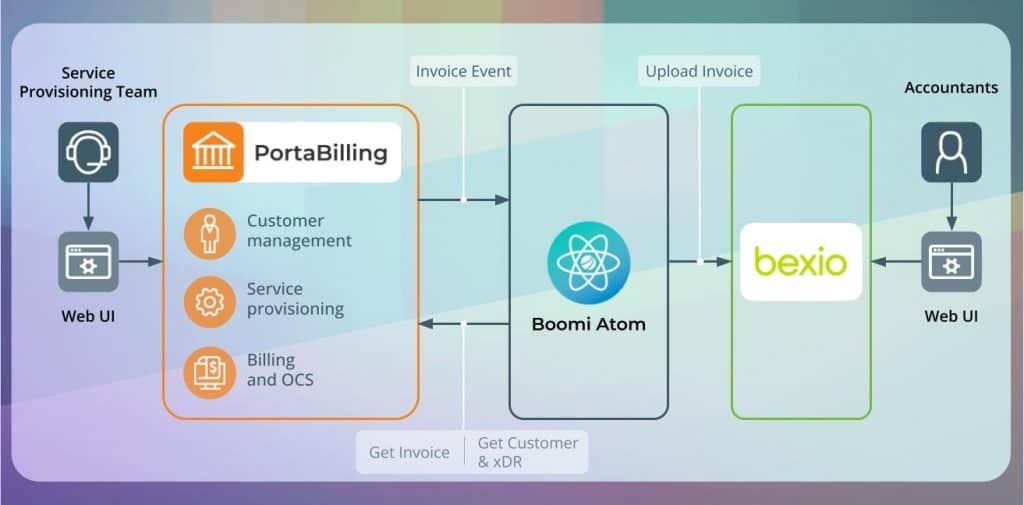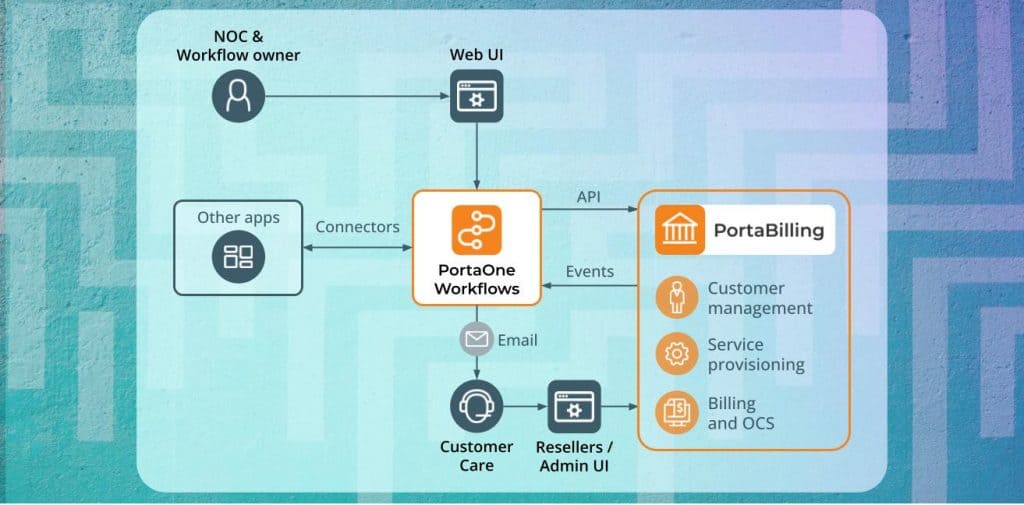Like all tech-based industries, the telecom world is dynamic and fast moving. So, if you’re hearing a lot these days about workflow automation, it’s because, right now, it is the primary way to keep your telco operations exactly as dynamic and fast-moving as they need to be. Well-designed and integrated workflow automation is the absolute key to operational excellence in telecom today. And that means it’s the absolute key to success! So, obviously, we’re dedicating this story to explaining the significance of workflows in the telecom sector.
And, of course, along the way we’ll help you get to know a bit more about PortaOne Workflows. This powerful automation tool is helping telcos revolutionize their operations in some very unique ways – stay tuned for more on that.
What Is a Workflow? And What Exactly Do We Mean by Workflow Automation?
When we talk about workflow automation we’re talking about the streamlined and systematic execution of tasks, processes, or activities within an organization. More than that, we’re talking about having the ability to execute those tasks with minimal manual (meaning, human) intervention. Think: A new customer creates an account, purchases an eSIM, and makes a payment using your e-commerce channel. All of that data is automatically synced to your accounting, billing, and CRM platforms, without any human team member needing to do any human work. (More on this soon.)
And it works like a dream, too. Telecommunication companies worldwide are adopting this kind of automation technology to transform laborious manual processes into streamlined, user-friendly workflows. As a result, they are enjoying lots of benefits:
- They have lower operational costs.
- They have heightened productivity.
- And, ultimately, they have increased customer satisfaction.
The tasks that workflows are designed to automate tend to be repetitive, rule-based, and time-consuming. Picture the kinds of things that you probably hate to do: hours of data entry; transferring account information from one program to another; tabulating, generating, and sending invoices; reconciling records… 😐🥱💀
A Hard Truth: Typos Are Inevitlbe 😉
And if you’ve ever done this type of work yourself, you know that the more hours you spend doing it, the more likely you are to make an error. (Yes: if you have fingers, you can make a typo.) Workflow automation uses various software tools and platforms to enable the efficient and consistent handling of data. It leverages predefined rules and logic to automate the flow of information, trigger actions, and coordinate the sequence of tasks. Most importantly, it can do all this without the need for anyone to ever put a hand to a keyboard.

Fewer Resources, Better Results
Taking the human factor out of these repetitive processes does more than just free up human resources and preserve office-worker sanity. In fact, with workflow automation, a telco business can:
- Reduce errors
- Enhance productivity
- Save time
- Improve collaboration
- And achieve greater operational efficiency
And while we (obviously) are focusing on the benefits of workflow automation in telecom, these processes are being rapidly adopted to manage sequential, repetitive tasks across a vast range of domains. That includes manufacturing, supply chain logistics, services provisioning, information processing, and more.
Why Is Workflow Automation Necessary?
Just how important are automated workflows, you ask? Maybe you’re thinking that the need to do all that repetitive work only affects a few entry-level employees. Or, maybe you’re thinking it doesn’t do a lot of harm to the larger company. Well, at the risk of sounding a bit dramatic, without workflow automation, everyone is going to suffer. That includes those entry-level data clerks, and it goes right up to the CEO.
Don’t believe us? To illustrate, here are a few staggering stats about neglected workflow automation to back up our big words:
- Your employees are spending 20-40% of their time on document retrieval.
- Task switching (a.k.a. multi-tasking) is hurting your productivity by 40%.
- Even if you are the top dog at your company, you are probably devoting about 25% of your time to automatable tasks.
And here is a really scary one. The typical error rate for manual data entry is 1%. Sounds small? Think about how many data points a typical clerk will need to enter in a typical session. Hundreds? Thousands? Consequently, at one error per every 100 data points, those mistakes are going to add up.
More Platforms, More Problems
And don’t forget! Telecom is very much a tech-based industry. To operate at our best, therefore, we need so! many! systems! And those systems aren’t always designed to work together.
On any given day, a telecom team might need to work with a CRM platform, an accounting platform, a billing and charging platform, an ERP platform, e-commerce shops, and more. And, of course, there are all of the network elements (such as HLR that stores the data of active SIM cards; PCRF that ensures a customer gets the bandwidth and quality-of-service level they signed up for…) that support the delivery of your communications services.
And as SaaS applications become more and more prevalent in the industry, there can be more and more fragmentation between existing data stacks. This is something we see often ourselves with new customers.
“Customer data lives across so many multiple platforms,” says Klaus Haertel, our director of strategic alliances and channel sales. (He is often a first point of contact for telcos when they approach us for an integration solution.) “That can lead to problems such as duplication or the need for manual data entry or copy and paste across various platforms.”
And inside that work, if you recall, is where that treacherous little 1% error rate is lurking.
The Even Bigger Picture
And even if you have the most nimble-figured data entry staff (so, somehow no errors) and the the most consistent processes (so, somehow no inter-system data compatibility issues), there are bigger problems you might meet along the hard road of zero automation:
- Limited scalability: A manually based operation can only grow incrementally, not exponentially. The same problem applies to your ability to work with resellers, too: without an easy and instantaneous way to collaborate and share data, there are only so many reseller relationships you are going to be able to maintain.
- Painful integrations: Imagine the difference between traveling on a single express train on a rail line that has an automated track-switching system, and traveling on a patchwork of rail lines where you have to disembark with all your luggage at every other station and then reboard a different kind of train on a different track, complete with buying new tickets, finding new seats, and getting to know a whole new set of possibly annoying seatmates on each leg. (And then imagine that all your potential revenue is sitting in a pile at your final destination. It’s just waiting for the first to arrive… and your competitors are on the express train.)
- Vendor lock-ins: Worse, you could try to fulfill all the functions you need with a single unified “black box” platform from a major software vendor, and end up not being able to integrate it with any outside systems or otherwise expand or customize its abilities in any way.
- Delayed product launches: Obviously, more manual workflows means slower development processes and slower service delivery. That means your customers will be waiting longer for the new products and services they need – and are seeing advertised elsewhere.
Eek, Hidden Costs!
Oh yeah, and here’s a big one. As anyone who has ever done a home renovation knows, almost every major do-it-yourself project is going to cost more than you thought it would. (Sometimes much, much more.) The same is typically true for do-it-yourself software integrations that have to be developed from scratch using a team of engineers. And this can be doubly true when it comes to asking a major vendor to provide you with new features or integration assistance for their “black-box” software. (Hello, vulture licensing!)
Yes, Integration Is the Solution! (But There Is a But…)
Here, unsurprisingly, is where we tell you that all of these challenges can be overcome with well-implemented custom workflow automation integrations that:
- Automate business processes and workflows
- Synchronize data
- Behave as an application or service for telco systems
But here’s the “but.” Sometimes, these integrations are fairly static. That can make them difficult to adapt once you have put them into place. Subsequently, for a fast-moving telco that needs to update its systems regularly, this can mean that a given integration is out-of-date or is no longer useful within a year, or even within months. So much for saved time, effort, and money.
Here’s where PortaOne Workflows enters the chat. Our vision for it entailed creating a versatile tool capable of aiding CSPs, ISPs, UCaaS providers, and telcos of all other types with an automated workflow, ensuring seamless data synchronization across the platforms they rely on.
And are we ever not just talking about data syncs! Yes, PortaOne Workflows is designed to reformat and trade data. But it is also designed to automate processes and integrate different apps and services.
In the big picture, our goal with this tool is to allow you as a telco provider to:
- Keep your current technology stack in sync
- Scale your operations while keeping your costs down
- Adjust each integration without coding if and when changes are needed
What Is PortaOne Workflows?
So that’s what PortaOne Workflows does. But what is it, exactly? In short, PortaOne Workflows is a user-friendly integration platform that seamlessly connects your existing technology stack, including CRM, accounting, customer engagement, and e-commerce platforms, with PortaBilling. That enables the integration you need to empower your business.
“PortaOne Workflows is designed to allow anyone to create and maintain their own app integrations, even if they are not an engineer or professional developer” says Andriy Zhylenko, CEO of PortaOne. “The low-code approach and the enormous selection of connectors that already exist in the Boomi catalog make it easy to add the necessary third-party tools and to successfully integrate those tools with PortaSwitch .”
The result? More flexibility, and a shorter time frame for implementation.

What Do We Mean by Low-code and No-code Platforms?
So, what is low-code? Low-code (and no-code) development is a way to build new applications and processes with little or no need for – you guessed it – writing code.
Think of them as an infinite and exchangeable collection of boxes that you can snap together like a Meccano set, rather than building a machine from scratch starting from unprocessed metal ore. Starting with functional, no-code pieces means there is little to no need for expensive software engineers. This also means that, by using these tools, a smaller, independent operation (like a telecom) can expand their capabilities by adding on new products and services, create integrations to automate their data flows, and join up different systems to make applications that were not designed to work together, well, work together.
If this seems new, well, it is and it isn’t. The history of no- and low-code actually goes waaaay back to the days of Fortran. That’s a fascinating story in itself that we blogged about here.
Workflow Automation Case Study #1: Efficiency at ECN
In short, low-code and no-code tools have become essential for telecom providers if they want to stay profitable and growing. In long, let’s illustrate this with a few case studies from some of our customers, starting with ECN.
ECN is a South African-based CSP that offers a broad set of cost effective voice, data, and hosted services. Their old data-sync component was written using the “classic” software development process and so had three fundamental problems:
- It was difficult to maintain
- It required too much time to implement new data flows or adjust existing ones (such as new parameters or conditions)
- It increased their need for time-consuming and resource-draining manual data entry
So, ECN adopted PortaOne Workflows. By capitalizing on new implementation via the addition of low-code applications, ECN traded an inefficient, error-prone and resource-demanding collection of processes into a single, efficient and integrated system. You can read the whole story here. But, to give you the highlights, this operational transformation:
-
- Reduced ECN’s maintenance efforts
- Enhanced their data sync process with new attributes and conditions
- Increased the reliability of their data and reduced errors
And thanks to no-code tools (which are available to all PortaOne customers via the Add-on Mart – more on that soon), they did it all using their in-house specialists. Additionally, they did it without having to bring on anyone with software development experience.
Oh, and one more thing! ECN did all of this in two months. In contrast, using the traditional software development approach, it would have taken up to six months.
Workflow Automation Case Study #2: iPaaS in Telecom at Premitel
In this success story, we used PortaOne Workflows to help Premitel, a South African ISP and long-time PortaOne client, address a wide range of issues:
- A lack of integration across their multiple external systems
- A lengthy (and costly) process for individual integrations
- Difficulty in making adjustments once those integrations were implemented
The solution in this case was to leverage PortaOne Workflows as an Integration Platform as a Service (iPaaS). As a result, that made it faster, easier, and cheaper for Premitel to connect all those external systems (payment processor, HubSpot CRM, Xero accounting) with PortaBilling to create one seamless system.
The result? In fact, a lot:
- Fast and flexible integration and automation capabilities
- Full synchronization between PortaBilling, HubSpot, and Xero
- The elimination of redundant data entry
- Fewer human errors (like, way fewer)
“With PortaOne Workflows, we are now able to automate and sync some of the key points of our business operations,” Kobus Venter, CEO of Premitel, told us when we were writing the full success story on this very project. “When new prospects turn into paying clients of Premitel, all the data on them, which already exists in HubSpot, is automatically synced with Xero Accounting. This frees up our time for things that bring immediate value.”
Venter also added that the integration process was fast. “We could connect the apps right away and start testing the synchronization process for the first select customers,” he said.
Workflow Automation Case Study #3: eSim Activation for a U.S. MVNO
eSIM activation has, obviously, gained immense popularity among telecom operators in recent years. Typically, it involves the integration of their mobile network, WSN (Wireless Sensor Networks) for user data, and an external system dedicated to eSIM generation and management.
But the process can come with a whole bunch of challenges:
- Integration complexity: You have to coordinate multiple systems, like mobile networks, and external eSIM systems.
- High cost: Going cheap on the implementation can result in compromised functionality.
- Time constraints: eSIM activation services are a fast-moving game. That means you have to stick to very tight timelines to stay ahead of the competition.
Low-code solutions (ahem, accomplished via a tool like PortaOne Workflows) can help operators get past these challenges and efficiently orchestrate the entire eSIM activation process. To demonstrate, here’s how:
- Simplified integration: Low-code workflows streamline the integration process for a seamless eSIM launch.
- Lower costs: By utilizing workflows, operators can achieve that magic balance of keeping cost low without compromising on performance.
- Quick deployment: The low-code approach enables swift implementation. Indeed, that allows operators to launch eSIM activation services faster.
In fact, we helped a mass-market MVNO based in the U.S. (name redacted for proprietary purposes, so you’ll have to use your imagination!) automate their eSIM activation this way. We also helped them with porting and other essential workflows. And we did it, of course, using PortaOne Workflows.
Workflow Automation Case Study #4: Simplified Back-end Flows for Virtual Call
Our customer Virtual Call had found plenty of success in Switzerland and Brazil with cloud PBX, voicemail, receptionist, and auto-attendant services. Yet, their small team faced many challenges:
- Insufficient workforce managing complex accounts and a vast range of activities
- Small changes requiring precious time: from minutes to hours
- Limited scalability and the inability to expand to larger contracts and customers
In other words, they had all the ingredients in place to achieve success… But, due to the high need for manual labor in their existing processes, they could not scale like they needed to. So, we put PortaOne Workflows to work:
- We helped them increase their range of services.
- We wiped out much of their need to have humans do manual and repetitive tasks (without the need to compromise on their high-level of customer support).
- We freed up their sales team to spend their time on strategizing for growth and onboarding newer, larger clients – instead of trying to keep up with busywork.
Read the whole story of what workflow automation did for Virtual Call to get the big picture. Expect guest appearances from HubSpot, cloud PBX self care, Bexio, MS Teams, and, of course, PortaBilling.
5G and 5G Policy & Charging Workflows
So now you’ve seen a few real-world examples of using workflow automation / iPaaS. You can see how it simplifies business processes, connects systems, and enables efficient data synchronization. Now it’s time to check out the uses of PortaOne Workflows implementation for API service within 5G telecom systems. To that end, let’s give you three big ones:
- Dynamic interaction: PortaOne Workflows can help you enable PortaBilling, PCRF, and other mobile network components to interact dynamically, thus controlling user access to the Internet based on content.
- Flexible bundling: Using workflows, you can design tailored bundles to reach niche markets within your region or sector. (Say, unlimited social network access, or 20 GB of YouTube streaming, or whatever your specific market wants.)
- Smart bundle management: This one is best described with an example. So, let’s use that 20 free GB of YouTube streaming. When that 20 GB is depleted, the PCRF can instruct the DPI (data packet inspection) to stop differentiating traffic from a specific resource (in this case, YouTube) from other traffic. Now, that YouTube traffic will go through the regular metering process.
PCRF Party
Wondering about implementation? To be sure, we have you covered. You can seamlessly connect the Policy and Charging Rules Function with PortaBilling using the API service based on 3GPP standards. Plus, proven interoperability between PortaBilling and Pharos PCRF ensures a smooth and reliable integration process.
Add-on Mart vs. Workflow and the “True iPaaS”
We mentioned above that we would delve a bit into the PortaOne Add-On Mart. Now, the time has come for that part of the story. Specifically, we want to help you understand the difference between the Add-on Mart and PortaOne Workflows. (Something that is often necessary since they both have links to the term iPaaS, which can get confusing.) So, here goes.
Add-on Mart (formerly PortaOne iPaaS)
We developed the Add-on Mart to give our customers an easy way to expand the functionality of PortaSwitch through cloud-based microservices. Our Add-on Mart used to be called PortaOne iPaaS and you may still see that term used for it in old PortaOne documentation.
By giving telcos immediate access to no-code and low-code tools that they can use to put new products and services into the market immediately (and to create integration between their systems), our Add-on Mart addresses the long wait between a request for a new integration (such as, say, a new payment processor) and the time when that new integration is available on the customer’s system. And that could be a while, since you need to account for solution design and implementation, then publishing the functionality within the next software maintenance release (MR), then scheduling an update to that MR and preparing for it, and finally executing the update. (“Long”? Yes, we release a new MR every seven weeks, but like we said, this is a fast-moving industry.)
Unlike regular MRs where code is added to PortaSwitch, with Add-on Mart, the code is deployed as microservices in the cloud. That facilitates quick and easy modifications and updates.
PortaOne Workflows
PortaOne Workflows (a.k.a. the star of this story), on the other hand, brings integrations to life not through microservice deployment but through an intuitive no-code/low-code interface, along with data transfer capabilities and API connectivity.
Integrations come to life through an intuitive no-code/low-code interface, along with data transfer capabilities and API connectivity.
It is also important to understand that PortaOne Workflows is based on Boomi. Why is that important? Because that connection to Boomi enables access to the vast Boomi library of pre-existing integrations. (In fact, there are 100+ integrations available, to help link PortaSwitch with common systems like HubSpot, SAP, Cisco, and others.)
And despite the vestigial and (hopefully) increasingly rare use of iPaaS to refer to the Add-on Mart, PortaOne Workflows really is iPaaS, down deep in its essence. Think of it as the one and only “True iPaaS” in this story.
Ready to Capture the Power of Workflow Automation?
If we have to use just one familiar ancient saying to summarize all the benefits of using workflows to integrate and automate your operations, it’s this: The whole is greater than the sum of its parts. (Borrowed with a nod to our problematic old friend Aristotle.)
Yes, a telecom needs many, many tools to manage customer accounts and design, deliver, and charge for services. But those tools do not need to operate separately, any more than your two hands need to operate with separate nervous systems. By using workflow automation, you can integrate those many tools into a seamless, greater whole. And PortaOne Workflows (especially combined with the Boomi process library) is, we think, the best way to create those integrations.
If you are ready to take all your moving parts and make them into a single machine, get in touch with our support team. We’re always happy to work with our customers to come up with creative, custom ways to improve your efficiency and set you up for success.
Summary and FAQs
Workflow automation is using software and software integrations to automate various business tasks that used to be done manually, such as data transfers, data format transformation, recurring actions, onboarding and provisioning, record keeping, some types of analysis, and so on.
PortaOne Workflows is easy-to-use, visual, low-code iPaaS integration platform that allows you to create automated workflows by connecting PortaBilling with other components of your technology stack, including your CRM, accounting, customer engagement, and e-commerce platforms.
PortaOne Workflows acts like a mediator between PortaBilling and various other systems and components, such as the web UI, applications like accounting, CRM, e-commerce, and some types of communications. Because PortaOne Workflows uses API (application programming interface) to communicate with the other applications, these integrations can be created using low-code or no-code tools.
PortaOne Workflows has several uses within 5G telco systems, including connecting the policy and charging rules function (PCRF), dynamic interaction between PortaBilling and other mobile network components, the creation of flexible and tailored product bundles, and the ability to better manage the delivery of those bundles.
Let’s stick to the big ones: reduced staff workload; lower operational costs; the ability to rapidly scale your operations; fewer errors (and therefore higher customer happiness); better collaboration; and a greater ability to expand the services you can offer. And did we say no more manual data entry?
Here is what Mike Britz of South Africa-based ECN had to say about PortaOne Workflows: “It’s been an eye-opener and business changer for us. Throughout the journey, we discovered that there are a lot of other things that you could possibly use to add value to your business, which was very exciting.”
You read about more happy PortaOne Workflows users in our customer success stories, including MVNE, Onsim, Virtual Call, and more.











